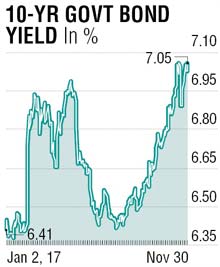
US markets got what they have been expecting for months – a tax reform package that would aim to benefit the corporates significantly and pave way for the movement of businesses back into the US. A package that would increase national debt by over a trillion dollars in a 10-year period would still need to be approved by the senate committee but it seems more of a formality, now.
US dollar, which has remained weaker for some time now, should get a shot in the arm. Last week, the Dow Jones bellwether index rose to historic highs and also registered its best weekly gain of the year.
The week was also dramatic for the cryptocurrency followers as bitcoin traded above $10,500, after the US derivatives regulator said it would allow CME Group and CBOE to list bitcoin futures. In other developments, Opec extended its output cut for a further nine-month period. US Treasury yields inched higher as strong economic signals and improved prospects for tax reforms saw pressure on bond prices.

However, two US Federal Reserve (Fed) policymakers urged caution in raising interest rates saying that the flattening of the yield curve was a signal the central bank should proceed slowly. Bank of England governor’s warning that sterling 26 trillion of derivative contracts cleared through London could be at risk if Brexit negotiations ignored UK Banks’ passporting rights should sink-in in the coming days in financial markets
Indian bond markets continue to struggle to find its feet as the spike in India VIX, volatile crude prices with another extension to output cut, RBI’s somewhat hawkish stance even when average inflation is expected to be fairly below the targeted level, keeps buying appetite abysmally low. Recent ratings upgrade by Moody’s has failed to sustain the initial euphoria, largely due to the fact that foreign institutional investors are full up on their limits.
Markets generally tend to overprice risk inasmuch as it does growth optimism. In the current case, a part of the MPC has been overtly cautious on inflation overshoot, coming as it does at a time when there are concerns of fiscal breach due to fall in revenues. The other fear that bond street is fighting is the uncertainties surrounding the recapitalisation (of banks) plan.
The combined effect is one of weaker sentiment and this does not appear to go away in a hurry as RBI’s policy committee meets over two days in the coming week. Not a great time for Indian bond traders. The rate curve is still steep enough in comparison to other major economies and carries sufficient kinks for the relative value investor to benefit from. Therefore, one can look for buying opportunities once the uncertainties arising out of RBI and Federal Reserve rate-setting meetings are over. With the current benchmark bond in circulation in excess of Rs 1.1 lakh crore, the likelihood of a new benchmark bond issuance soon is also higher.
On the data front, November's factory growth showed the sharpest increase in a year, in endorsement of the fact that demonetisation led blues are over. India’s GDP growth jumped to 6.3% in the September quarter, up from a three-year low of 5.7% in the June quarter, an indication the Indian economy has shaken off the lingering effects of demonetisation last year and GST rollout this year. Although a provisional one, it could well be a sign of bottoming out of weak-growth phase.
Range for benchmark yields is favoured between 7.10%-6.90% with break of contours resulting in sharp moves.
The writer is a market expert